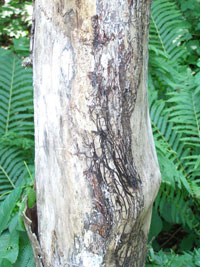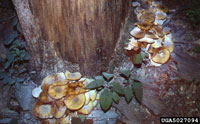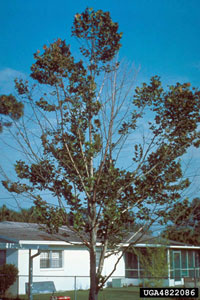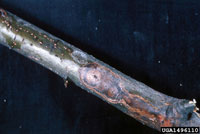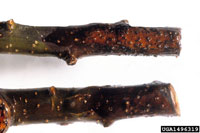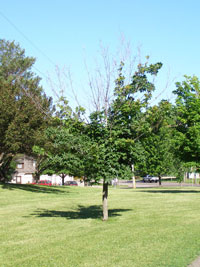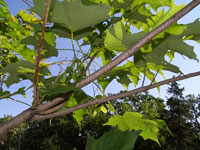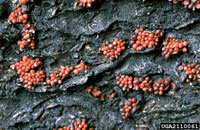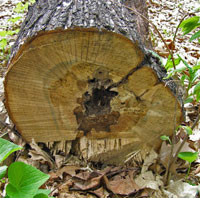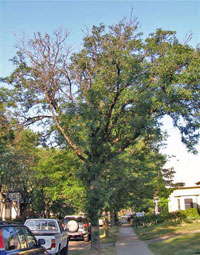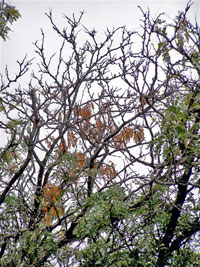Extension > Garden > Diagnose a problem > What's wrong with my plant? > Deciduous Trees > Hackberry > Leaves wilt and turn yellow or brown
Hackberry > Leaves > Leaves wilt and turn yellow or brown
1 of 5
Armillaria root rot
Armillaria spp.
- Infected trees have poor growth, dead branches in the upper canopy, undersized and/or yellow leaves
- Flat white sheets of fungal mycelia (mycelia fans) grow between the bark and sapwood at the base of infected trees
- Thick black, shoestring-like fungus can sometimes be seen under the bark, around roots and in the soil around the base of the tree
- Wood is decayed, white, soft and spongy, and this may extend from the base of the tree well up into the trunk
- Trees frequently break or fall over in storms
- Clusters of honey-colored mushrooms may grow at the base of the tree in fall
- More information on Armillaria root rot
2 of 5
Branch cankers
Botryosphaeria stevensii or Botryosphaeria spp.
- Scattered dead branches seen throughout canopy
- Leaves on random branches wilt, turn yellow then brown during the growing season
- Infected branches don't leaf out in spring
- Cankers are brown to black sunken areas on branch that may have cracked bark and discolored sapwood
- Common on trees stressed by drought, winter injury, wounds, insect feeding or other factors
- More information on canker
3 of 5
Coral spot canker
Nectria cinnabarina
- Dead branches and twigs, often first observed in early spring when no leaves form
- Or, wilting soon after leaves emerge in spring
- Sunken dark brown area on branch that is often cracked or has a ridge at the edge
- Raised cushion-like bumps on affected branches, may be cream to orange or red, turn black with age
- Common on trees stressed by drought, recent transplant or
other factors - More information on canker
4 of 5
Heart rot
Polyporus squamosus, Laetiporus sulfereus and others
- The canopy may show no symptoms or may have small yellowing leaves/dead branches depending on the extent of the trunk decay
- Fungal fruiting bodies arise along the stem, near a pruning wound, crack or other wound
- Many shapes and sizes of fungal fruiting bodies may be seen
- In cross section of the trunk, the wood at the center is discolored, soft, crumbling, stringy or spongy
- More information on heart rot
5 of 5
Ganoderma root and butt rot
Ganoderma spp.
- Leaves are smaller in size and turn yellow earlier than normal
- Canopy appears thin with few leaves and multiple dead branches
- Fungal conks, a semicircle shelf fungi, can be found from the base of the tree up to 3 feet high on the trunk
- Conks are reddish brown and shiny on top, white and porous underneath; a rim of white may be visible on the edge of
growing conks - Infected wood at the tree base is white, soft, stringy or spongy
- Infected trees frequently break or fall over in storms
- More information on Ganoderma root and butt rot




